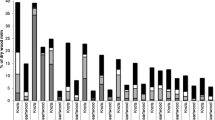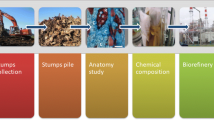Abstract
The distribution of lignans in knots, i.e., the branch bases encased in the stemwood, and in the adjacent stemwood of Norway spruce (Picea abies) was studied. Hydrophilic extracts in samples of three annual rings from the side wood of knots, as well as samples from the surrounding stemwood, were analysed by GC and GC-MS. The knots had an exceptionally high content of lignans (up to 15% w/w), compared to the stemwood (less than 0.05% w/w). The content decreased clearly in the radial direction from the knot pith towards the outerwood, to come down to the same level as in the surrounding stemwood. In the branches, the lignan content also decreased in the radial direction from the branch pith outwards. The lignan content decreased sharply outwards in the branches and came down to the same levels as in the stemwood already 20 cm outside of the stem.
Zusammenfassung
Es wurde die Verteilung von Lignanen in Ästen und im umliegenden Stammholz von Fichte (Picea abies) untersucht. Hydrophile Extrakte in drei Jahrringen von Astproben und dem umgebenden Stammholz wurden mittels GC und GC-MS analysiert. In den Ästen fand sich ein aussergewöhnlich hoher Gehalt an Lignanen (bis zu 15 Gew-%) im Vergleich zum Stammholz (weniger als 0.05 Gew-%). Der Gehalt fiel deutlich in radialer Richtung vom Mark des Astes ab und erreichte aussen den Wert des umgebenden Stammholzes. In Längsrichtung der Äste von aussen erreichen die Werte schon 20 cm vor dem Stamm die Grössenordnung der Stammholzgehalte an Lignanen.
Similar content being viewed by others
References
Boutelje JB (1966) On the anatomical structure, moisture content, density, shrinkage, and resin content of the wood in and around knots in Swedish pine (Pinus sylvestris L.), and in Swedish spruce (Picea abies Karst.). Svensk Papperstidn. 69(1):1–10
Eckerman C, Holmbom B (2001) Method for recovery of compression wood and/or normal wood from oversize chips. Patent application, PCT/FI101/00691, 22 pages
Ekman R (1979a) Distribution of lignans in Norway spruce. Acta Acad Abo, Ser B 39:6
Ekman R (1979b) Analysis of the non-volatile extractives in Norway spruce sapwood and heartwood. Acta Acad Abo, Ser B 39:20
Ekman R, Holmbom B (1989) Analysis by gas chromatography of the wood extractives in pulp and water samples from mechanical pulping of spruce. Nord Pulp Pap Res J 4(1):16–24
Ekman R, Peltonen C, Hirvonen P, Pensar G, von Weisenberg K (1979) Distribution and seasonal variation of extractives in Norway spruce. Acta Acad Abo, Ser B 39:26
Holmbom B, Eckerman C, Hemming J, Reunanen M, Sundberg K, Willför S (2002) Method for isolating chemical substances from wood. Patent application, PCT/FI02/00418, 33 pages
Holmbom B, Hemming J, Willför S, Reunanen M, Nisula L, Eckerman C (2003) Phenolic bioactive substances in wood and knots of different spruce and fir species. In: Proc. 12th Inter. Symp. Wood Pulping Chem., University of Wisconsin-Madison, vol 1, pp 341–344
Höll W (1985) Seasonal fluctuation of reserve materials in the trunkwood of spruce (Picea abies (L.) Karst). J Plant Physiol 117:355–362
Kimland B, Norin T (1972) Wood extractives of Common Spruce Picea abies (L.) Karst. Svensk Papperstidn 75(10):403–409
Lorbeer E, Zelman N (1988) Investigation of the distribution of the non-volatile lipophilic part of rosin in spruce (Picea abies). Holzforschung 42(4):241–246
Shigo AL (1985) How tree branches are attached to trunks. Can J Bot 63:1391–1401
Willför S, Hemming J, Reunanen M, Eckerman C, Holmbom B (2002) Wood knots – A novel rich source of bioactive phenolic compounds. In: 7th European Workshop on Lignocellulosics and Pulp, Åbo Akademi University, Åbo, Finland, pp 43–46
Willför S, Hemming J, Reunanen M, Eckerman C, Holmbom B (2003a) Lignans and lipophilic extractives in Norway spruce knots and stemwood. Holzforschung 57(1):27–36
Willför S, Hemming J, Reunanen M, Holmbom B (2003b) Phenolic and lipophilic extractives in Scots pine knots and stemwood. Holzforschung 57(4):359–372
Willför S, Nisula L, Hemming J, Reunanen M, Holmbom B (2003c) Lignans in knots of some Abies species used as pulpwood. In: Phytochemistry and Biology of Lignans, April 6–9, Bornheim-Walberger, Germany, Phytochemical Society of Europe, p 101
Willför S, Reunanen M, Eklund P, Sjöholm R, Kronberg L, Fardim P, Pohjamo S, Holmbom B (2003d) Oligolignans in Norway spruce and Scots pine knots and Norway spruce stemwood. Holzforschung 58(4):345–354
Author information
Authors and Affiliations
Corresponding author
Rights and permissions
About this article
Cite this article
Willför, S., Sundberg, A., Rehn, P. et al. Distribution of lignans in knots and adjacent stemwood of Picea abies . Holz Roh Werkst 63, 353–357 (2005). https://doi.org/10.1007/s00107-005-0024-5
Published:
Issue Date:
DOI: https://doi.org/10.1007/s00107-005-0024-5




